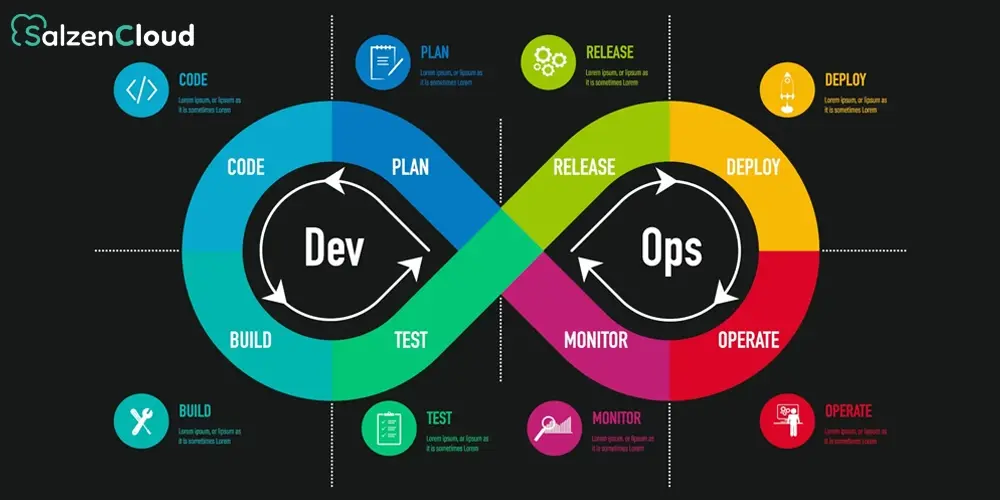How DevOps as a Service Works? A Step-by-Step Overview
January 14, 2025

Today, organisations seek ways to enhance their software development practices and deliver exceptional products more efficiently. And what better way than DevOps to expedite the process? The DevOps market hit over $10.4 billion in 2023 and is set to skyrocket with a 19.7% CAGR through 2028, all thanks to the push for faster development cycles and quicker delivery!
Cloud computing and agile methodologies have accelerated this momentum. But, what is DevOps, and how can organisations benefit from it?
This article breaks down DevOps as a Service and will show you how DevOps works and how it can transform your organisation's software game. We will also delve into prominent platforms such as AWS DevOps and Azure DevOps, highlighting their significance in this transformative process.
Understanding these elements will help you better appreciate how DevOps services can enhance efficiency and collaboration within your teams. Let us define DevOps first!
What is DevOps?

DevOps is mixing software development and IT operations to speed up the process. The goal? Faster development cycles, more frequent deployments, and better software quality—all by boosting team collaboration. Basically, it helps companies build and launch software faster and smoother by making dev and ops work nonstop together.
However, to genuinely comprehend DevOps, it is vital to look beyond the practices and embrace the tools and platforms that facilitate it. In this regard, DevOps consulting services are becoming indispensable for organisations that do not possess the internal expertise to execute a fully integrated DevOps strategy.
How DevOps as a Service Works?
DevOps as a Service involves outsourcing the entire DevOps pipeline to a specialised provider. This spans from coding and building to testing, deployment, as well as, monitoring—through cloud-powered services offered by external professionals. These managed DevOps solutions help organisations adopt the full range of DevOps practices. There is no need to maintain the infrastructure or recruit specialised talent.
Here is how it works step by step:
- Step 1: Define DevOps Objectives and Needs
Establishing clear objectives is the initial step in embracing DevOps as a Service. Recognise the challenges you wish to tackle. This may be accelerating development cycles, enhancing software quality, or fostering team collaboration. This aids in creating a targeted roadmap for success.
DevOps consulting services play pivotal in assessing your existing practices and pinpointing gaps. They then tailor a solution that aligns with your organisational goals. Customised guidance ensures that the adoption is efficient and meets your unique requirements.
- Step 2: Picking Tool - Azure DevOps or AWS DevOps
The prosperity of DevOps as a Service lies in picking the proper tools. AWS DevOps and Azure DevOps are the leading platforms that cater to this requirement. These cloud-powered platforms put forward various tools to automate workflows, support continuous integration and delivery, and monitor applications.
The tools - AWS CodePipeline, as well as, AWS CodeBuild optimise your workflow, thereby, speeding up delivery. Meanwhile, Azure DevOps puts forth Azure Pipelines and Azure Repos. Both platforms also deliver robust monitoring features. These include Amazon CloudWatch and Azure Monitor, which guarantee seamless application performance and ongoing improvement.
The decision to go with either Azure DevOps or AWS DevOps is completely influenced by your current cloud environment and team requirements.
- Step 3: Automating CI/CD Pipelines
The subsequent step is automating the CI/CD pipeline. Continuous integration and continuous delivery are fundamental DevOps principles. This lets teams automate software building, testing, and deployment.
Establishing automated pipelines can help your team minimise manual errors, enhance deployment speed, and uphold higher-quality code throughout the development lifecycle.
- Step 4: Implementing Infrastructure as Code
Infrastructure as Code is another crucial element of DevOps, amongst several others. Infrastructure can be defined and controlled through code by teams. This is version-controlled and automated, just like the application code. AWS CloudFormation and Azure Resource Manager templates help organisations streamline infrastructure provisioning and maintenance. This helps curb cumbersome manual processes.
Employing Infrastructure as Code can guarantee teams consistent and repeatable infrastructure deployments. Besides facilitating the scaling process, it also simplifies application maintenance. This approach is especially beneficial in cloud-powered environments such as AWS DevOps and Azure DevOps.
- Step 5: Tracking and Continuous Improvement
The final step is ensuring ongoing monitoring and enhancement once the pipelines are established and your infrastructure is automated. This is where DevOps services truly come into effect. Employing AWS CloudWatch or Azure Monitor can help you observe your application's health in real-time and pinpoint potential issues before they escalate.
Feedback loops that are consistent and regular play a fundamental role in the DevOps philosophy. With the right monitoring tools, teams can consistently refine and enhance the software development process. This ultimately helps them attain higher performance and improved customer satisfaction.
Top Benefits of DevOps Practices
Numerous benefits of DevOps can generate substantial value for your organisation. Below are several advantages of them:
- Accelerated Development and Delivery: Automated processes allow teams to quickly create, test, and deploy software. This significantly curbs time to market.
- Improved Collaboration: By uniting development, as well as, operations teams, DevOps fosters better communication and collaboration.
- Refined Quality: Automated testing and continuous monitoring ensure that applications are of the highest quality and help prevent bugs and vulnerabilities.
- Enhanced Scalability: Cloud-powered solutions such as AWS DevOps and Azure DevOps facilitate the straightforward scaling of applications. This can be done up or down according to demand.
- Cost Efficiency: Businesses can save time and money by automating essential tasks. This curbs reliance on manual work.
The Bottom Line
DevOps as a Service puts forward a holistic solution for organisations aiming to optimise their software development lifecycle. Businesses can achieve quicker development cycles by incorporating automated workflows with cloud-powered platforms such as AWS DevOps and Azure DevOps. They can also deliver superior-quality software. Additionally, this approach fosters a more collaborative working environment.
The advantages of embracing DevOps are evident. They are enhanced speed, improved collaboration, superior quality, and cost-effectiveness. If you seek to define DevOps within your organisation, there is no better moment to investigate DevOps consulting services and discover how DevOps can unlock new opportunities for your team.
For more information on DevOps, Infrastructure as Code, automated testing, AWS, and Azure, visit the Salzen Cloud website.
recent blogs


What is IaaS? Understanding the Basics and Benefits for Your Business
Read More
